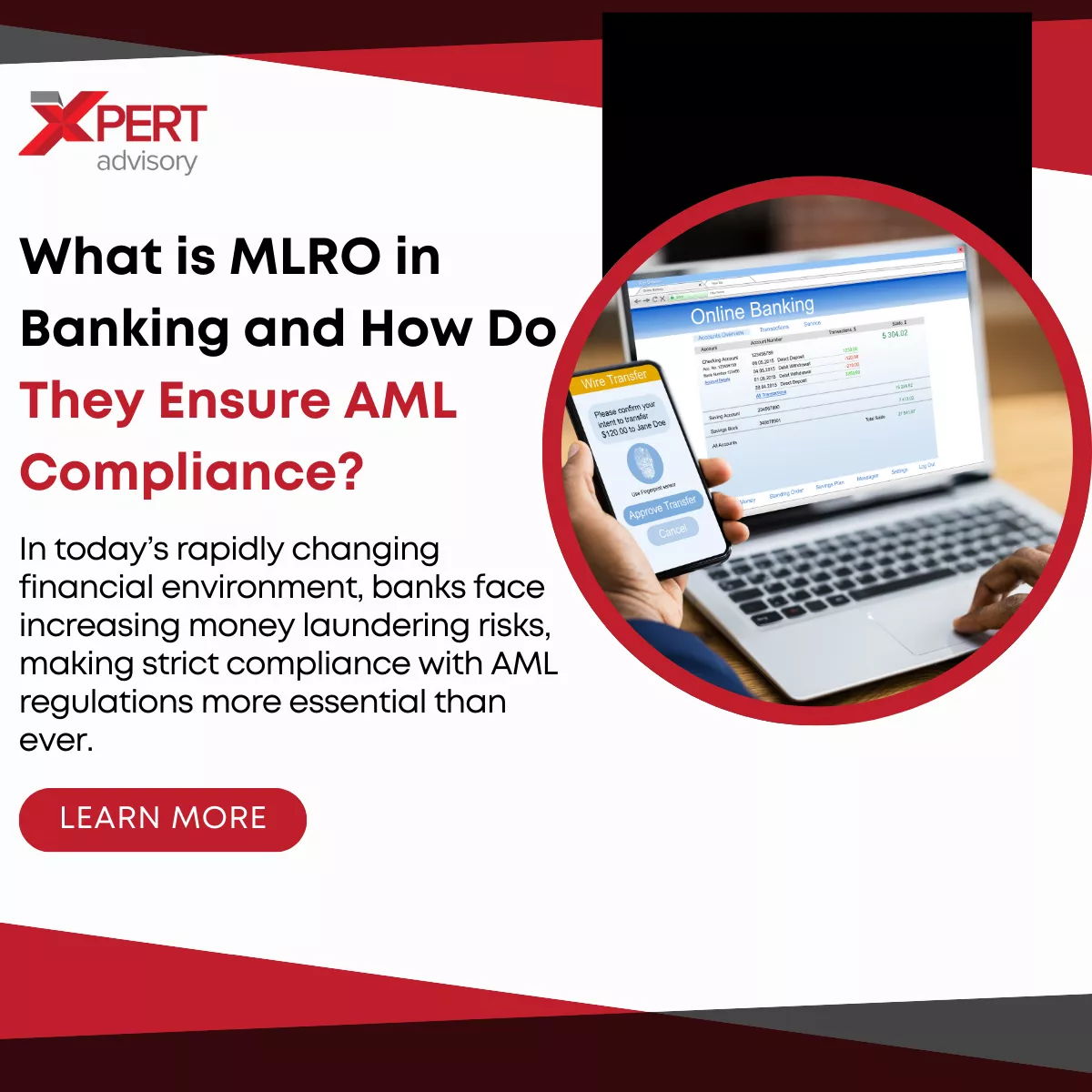In today’s fast-evolving financial landscape, banks are encountering elevated risks of money laundering, which makes adherence to AML regulations more crucial than ever. The Money Laundering Reporting Officer (MLRO) is an important participant in financial crime prevention and ensures AML compliance in the UAE. MLRO plays a key role in safeguarding banks by ensuring AML compliance and detecting suspicious activities. But what is MLRO in banking and how do they ensure AML compliance? Let’s dive into their responsibilities and impact on banking security in the UAE.
Money Laundering Reporting Officer in UAE

A Money Laundering Reporting Officer (MLRO) is an authorised individual who oversees anti-money laundering (AML) and counter-terrorism financing (CTF) compliance procedures at financial institutions and regulated organisations. An MLRO’s primary role is to combat financial crimes while also providing crucial financial crime information to appropriate authorities concerning suspicious transactions and individuals.
An MLRO plays an essential role for maintaining AML and CFT regulations across the banking sector in the UAE. The AML-CFT Decision through its Article 21 mandates financial institutions to designate suitable Compliance Officers who will identify suspicious financial activities and follow UAE laws strictly to prevent criminal activities.
Key Duties of MLRO in Banking

A money laundering report officer plays a crucial role in ensuring AML compliance in the banking sector and other financial institutions of the UAE. Curious about what is MLRO in banking responsible for? Here are the key duties of an MLRO in the banking sector:
- Developing and Maintaining AML Programs: The MLRO remains completely responsible for creating and implementing all anti-money laundering program components alongside persistent evaluation roles to make sure organization’s policies stay compliant with present money laundering regulations and stop money laundering activities.
- Conducting Risk Assessments: The MLRO performs risk assessments of customer profiles, products alongside services and geographical areas to identify money laundering and terrorist financing exposures which helps direct compliance strategies at the institution.
- Customer Due Diligence (CDD): As an essential duty in their role the MLRO verifies client identities while assessing financial activities to validate fund sources’ legitimacy with the goal of stopping financial institution criminal activities.
- Monitoring Transactions: MLROs must set up transaction monitoring systems which constantly observe banking activities so organizations can detect money laundering or terrorist financing activities by detecting unusual or suspicious transactions.
- Reporting Suspicious Activities: Upon identifying suspicious activities, the MLRO must execute approved reporting procedures to inform both Financial Intelligence Unit (FIU) and other relevant authorities as per regulatory requirements.
- Training and Awareness Programs: The MLRO conducts training sessions and awareness programs that train all staff members in anti money laundering (AML) and counter-terrorist financing (CTF) regulations so the organization develops both a compliant culture and stronger capabilities to detect financial crimes.
- Maintaining Records: The MLRO upholds full documentation systems with all records of AML activities including risk management and customer due diligence(CDD) practices and suspicious transaction reports that exist in an easy-to-access format for authorized regulatory audits.
- Liaising with Regulatory Authorities: The MLRO serves as the main connection between the institution and regulatory authorities by conducting reporting and facilitating cooperation throughout audits and investigations.
- Implementing Internal Controls: The Money Laundering Reporting Officer creates framework internal controls that enable the detection and prevention of money laundering while retaining operational security and following all applicable legislative requirements.
- Reporting to Senior Management: The MLRO gives regular updates to both senior executives and board members which present vital information about the effectiveness of the AML program functions along with operational recommendations for improvement.
Why Do Banks Need to Have an MLRO?
Banks, investment businesses, insurance companies, and real estate agents are among the regulated financial services sectors usually subject to the requirement. These financial sectors have a high volume of processed transactions thus they become more susceptible to money laundering activities. This is one of the strategic decisions made by the organization’s senior management. Here are some reasons to appoint an MLRO:
- Compliance Issues: An MLRO in the senior management protects the company from strict compliance penalties while demonstrating authentic dedication to money laundering prevention.
- Heavy Fines: Businesses which violate money fraud rules and AML policies undergo substantial monetary fines issued by relevant authorities.
- Reputational Damage: Participating in activities linked to money laundering leads to permanent damage of your organization’s reputation that endangers its public reputation.
- Legal Consequences: Individuals and organizations may face financial and criminal penalties under current legal frameworks under severe conditions.
The Role of MLRO Reports in Strengthening AML/CFT Practices in Banks
UAE banks implement strong AML/CFT practices through the essential MLRO reporting system. This system maintains compliance through its internal policy analysis while tracking suspicious actions to find shortcomings in regulatory rules. Cabinet Decision No. 10 of 2019 mandates financial institutions to deliver this report twice annually to senior management alongside relevant authorities at the Central Bank of UAE (CBUAE). The MLRO Report includes various important components which are as follows:
- Suspicious Activity Reports (SARs): The report analyzes Suspicious Activity Reports (SARs) to assess their quality, number of reports submitted and also evaluates client rejections stemming from missing or insufficient information.
- AML Training Compliance: The report presents documentation of AML training programs, assessment results while outlining areas where programs should improve.
- Customer Due Diligence (CDD) & Risk Assessment: The MLRO report includes Customer Due Diligence (CDD) & Risk Assessment sections that require reviewing customer files while verifying current risk ratings and providing regular assessment updates.
- AML/CFT Policies and Procedures: The evaluation of AML/CFT procedures analyzes AML processes, policy documentation and operational control systems to verify their compliance with UAE regulatory standards.
- Ongoing Monitoring & Recordkeeping: The system requires continuous supervision coupled with accurate record keeping and prompt reporting of suspicious financial activities.
Structured reporting functions from the MLRO help UAE banks design robust AML systems which defend banks against financial crime risks and help maintain regulatory standards.
Conclusion
MLRO is not merely a regulatory requirement but a cornerstone in the fight against financial crime. Through their dedicated execution of responsibilities MLROs both secure organizations from unlawful actions and preserve customers’ trust in financial institutions. The position of MLRO proves vital because regulatory environments keep changing alongside financial crime techniques becoming more complex. Organizations must permanently support their Money Laundering Reporting Officers because they play a crucial role in fighting newly appearing threats and maintaining regulatory compliance standards.
Want to stay ahead of financial crime? Build a strong compliance culture and meet UAE AML regulations with our tailored solutions. Whether you need risk assessments, transaction monitoring, or AML training, Xpert Advisory has you covered. Contact us today and get expert guidance to stay compliant in the UAE.
FAQs
What are the responsibilities of an MLRO in the UAE?
The MLRO works as an AML compliance leader and fulfills the responsibility to detect suspicious transactions and report them to regulatory bodies which maintains proper regulatory adherence.
Why do businesses need MLRO?
Organizations need dedicated money laundering reporting officers because they defend against financial risks and money laundering and meet compliance requirements to stay compliant with laws.


